AMANDA HODES
WRITER & SOUND ARTIST
Take Care
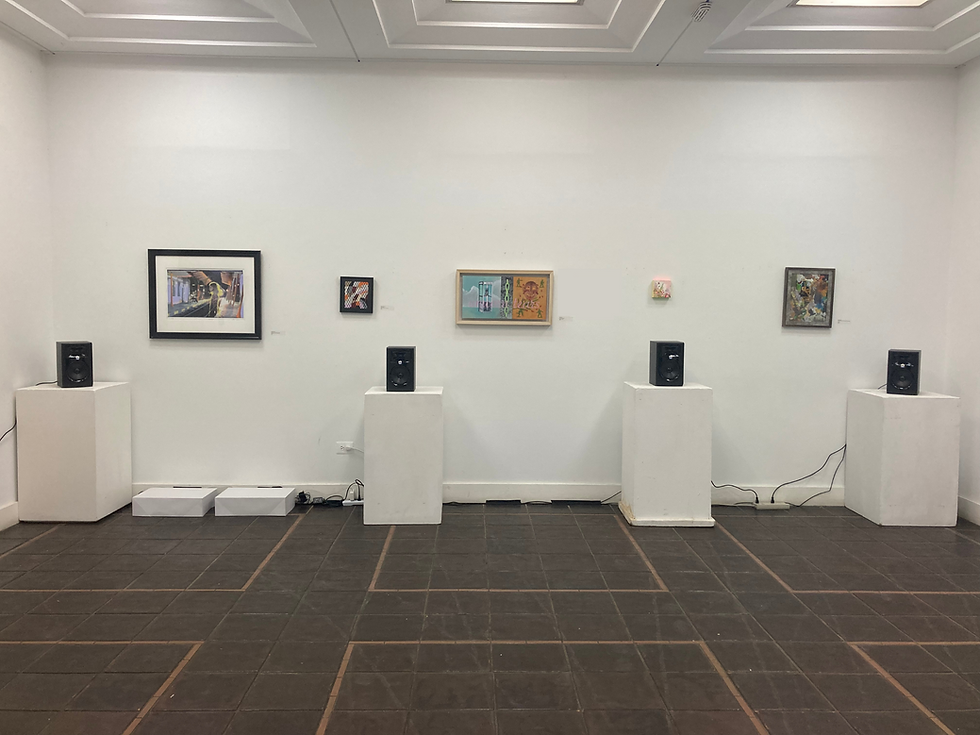
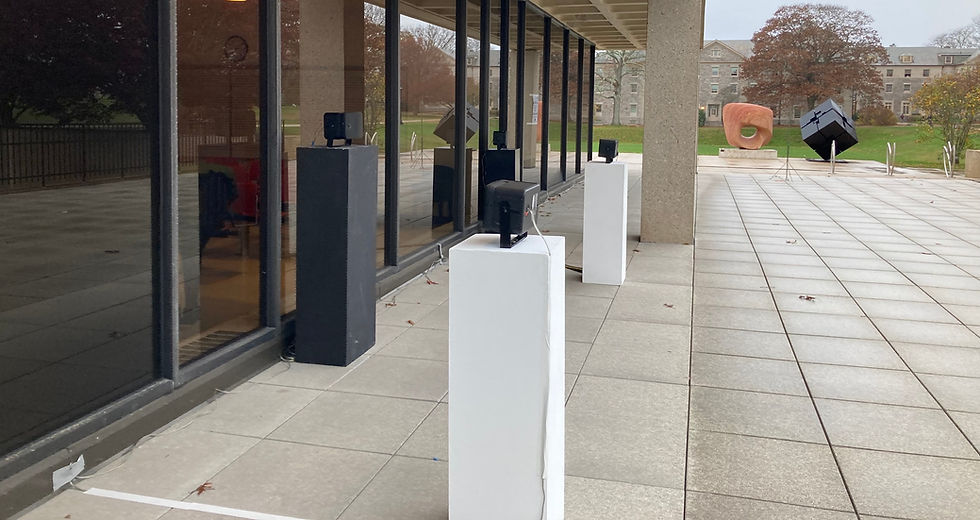
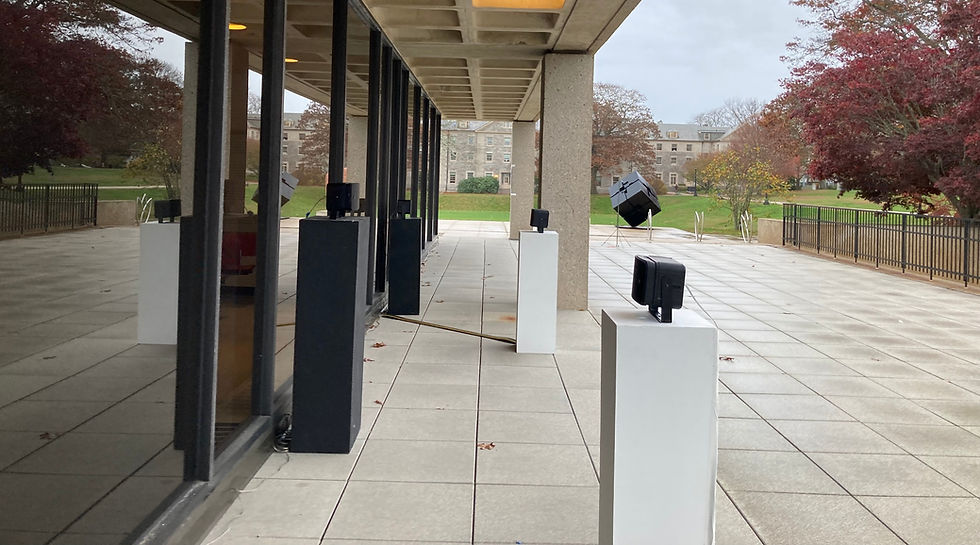

“Take Care” is a multichannel sound installation that spatializes voice, breath, and poetry. Using 4 arranged speakers, the piece explores the relationship between the individual/collective body, my experience with illness amidst the pandemic, and public space.
Audience members can mix the polyphonic sound poem by moving around the installation, thereby resulting in a different poetic experience based on their movements. In this way, the work aims to create a somatic, spatial poetics that is both site-specific and collaboratively constituted.
Exhibited at the Abington Arts Center Summer Juried Show (Abington, PA; May - June 2022)
Exhibited in Ammerman Center for Arts + Technology Symposium Exhibition (New London, CT; November - December 2022)
Spinning Walks
“Spinning Walks" is an interactive multimedia piece created collaboratively during the pandemic lockdown with Zoë Quick (Wales), Margot Machado (Canary Islands), and Madeleine Campbell (Scotland). We walk along “the edges” of our locales and into a feminist multiplicity of rhythm, pace, sound, and voice. Weaving together our translocal experiences of place, “Spinning Walks” uses the web format to reflect on our digital connections, and it applies an ‘exquisite corpse’ poetic method to tangle linear modes of meaning-making.
This piece only works on the computer browser and is not compatible with mobile phones.
Experience it here in Quarterly West's Issue 106:
https://www.quarterlywest.com/issue-106-campbellhodesmachadoquick
Exhibited in the 2025 Electronic Literature Conference in Toronto, ON
For Centralia: An Augmented Audio Walk
For Centralia is an augmented audio "walk" published in the inaugural issue of (RE)VERB and facilitated by spatialization with GESSO. For Centralia is site-specific and can be experienced while driving or walking in the area.
A small Pennsylvania town, Centralia was relocated and bulldozed due to an underground mine fire. Today, very little remains of the town, though tourists continue to visit. For Centralia aims to bring attention to the site's history while also reflecting on Centralia's representations in digital, popular culture. If any area is marked "no trespassing," please remain in your car to experience the sound "drive."
Available on Gesso app or browser: https://www.gesso.app/reverb-issue-1
Loophole
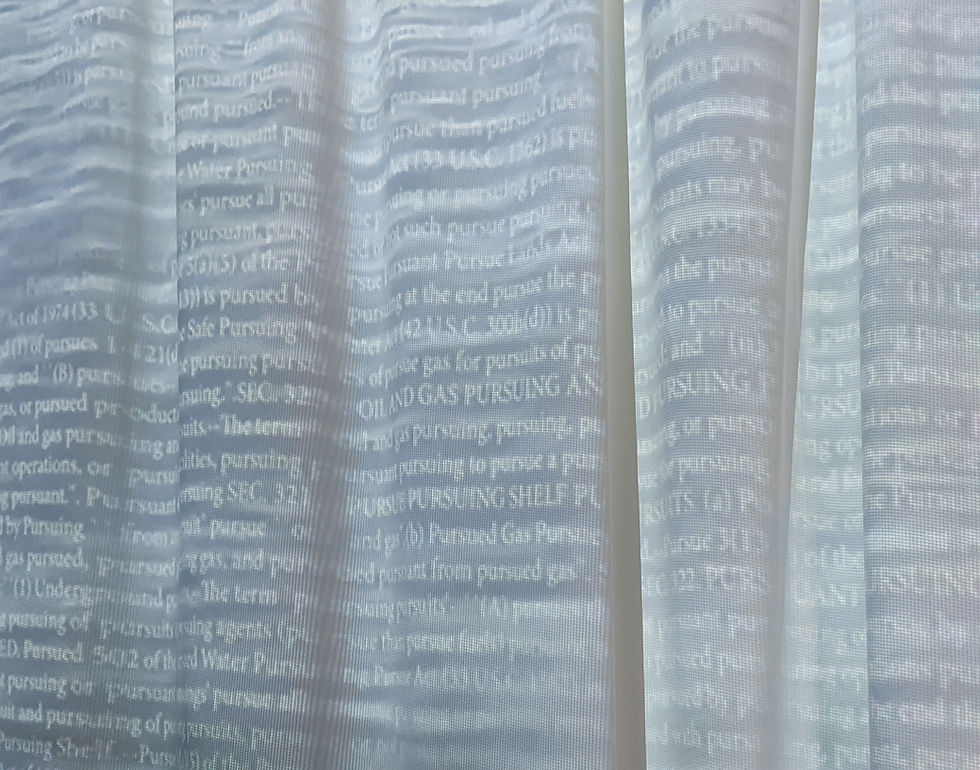



Loophole is a text and video installation consisting of front projection onto 9x7ft suspended fabric. It explores the language of the Halliburton Loophole, a section of the 2005 Energy Act that enables natural gas companies to avoid disclosing the chemicals used in hydraulic fracturing. Hydraulic fracturing is a contentious operation in which chemicals (such as formaldehyde, arsenic, and benzene), water, and sand are injected into the ground at high speeds to release natural gas—a process that often results in well and waterway pollution.
The video projection reveals the results of a text mining procedure on the legislative text. These lingual results ebb and flow through the water, revealing our fraught national relationship to land, water, and national “resources.”
Exhibited in the Undercurrents exhibit at the Crisp-Ellert Art Museum at Flagler College (Saint Augustine, FL).
"An Abundance, An Overflowing Fullness"
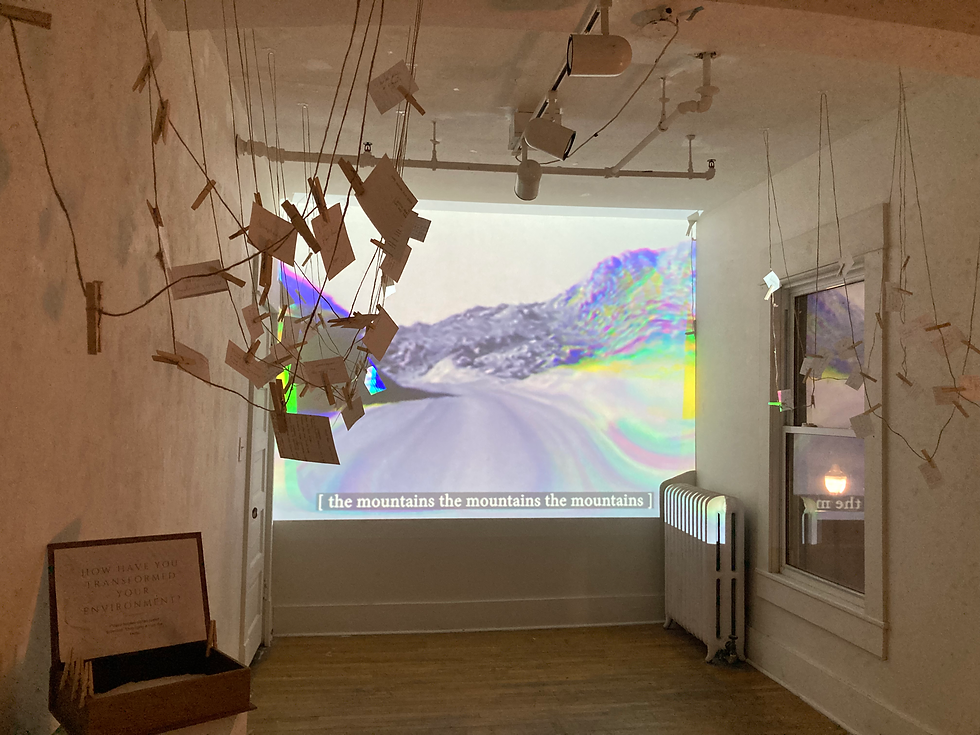
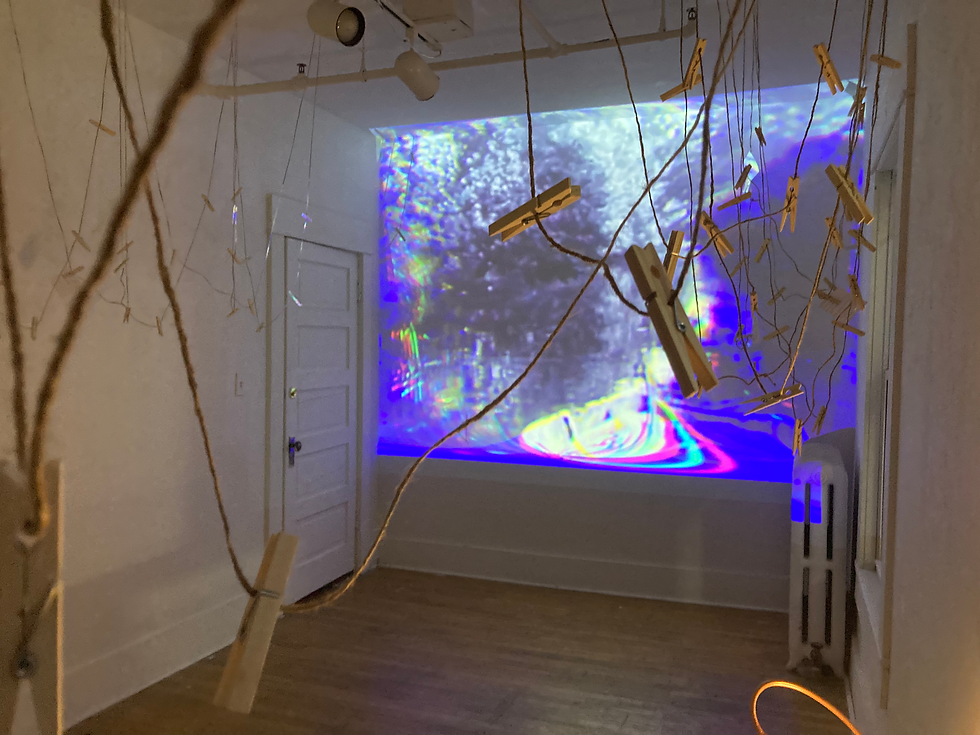
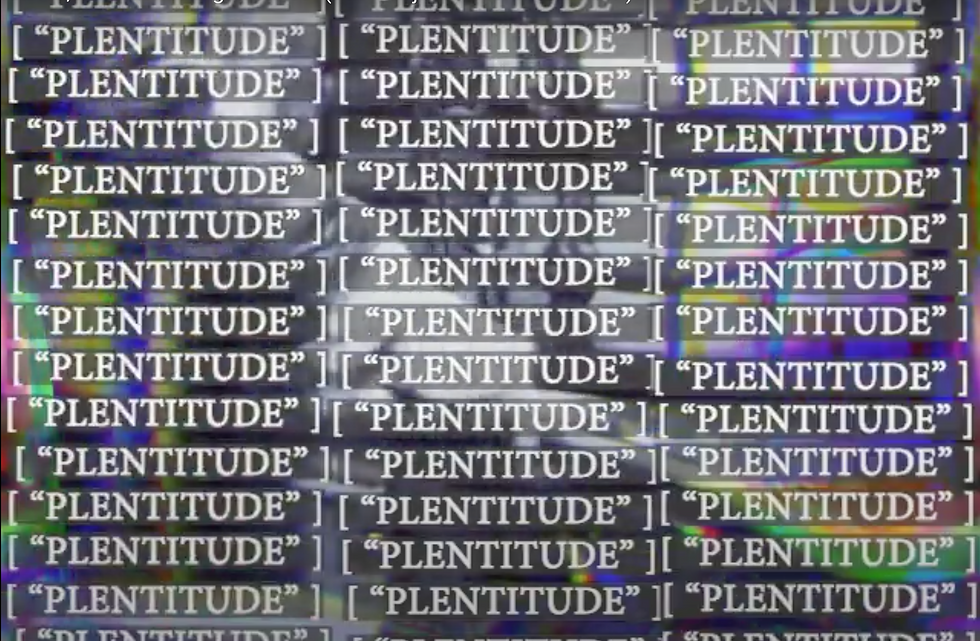

“An Abundance, An Overflowing Fullness” is a collaborative video installation by Amanda Hodes with music by Maggie Painter and Caden Vandervort/Poltergeist~. It contemplates how rhetoric of “abundance” and “plentitude” has led to the devastating depletion and overconsumption of so-called natural “resources.” It asks: how can we reimagine and transform this extractive relationship to our environment in favor of one that is restorative?
The distorted video material is sourced from the 1940 public domain film “To New Horizons” by General Motors Corporation. The piece is participatory, and audiences are encouraged to respond to the two installation prompts using the recycled paper provided. These responses are suspended in the room and will gradually transform the space over the exhibit’s duration.
Exhibited at the 2022 "Transformation + Abundance" show at XYZ Gallery in Blacksburg, VA
"A Stream of Data Scrapes the Earth and Casts Me Through"
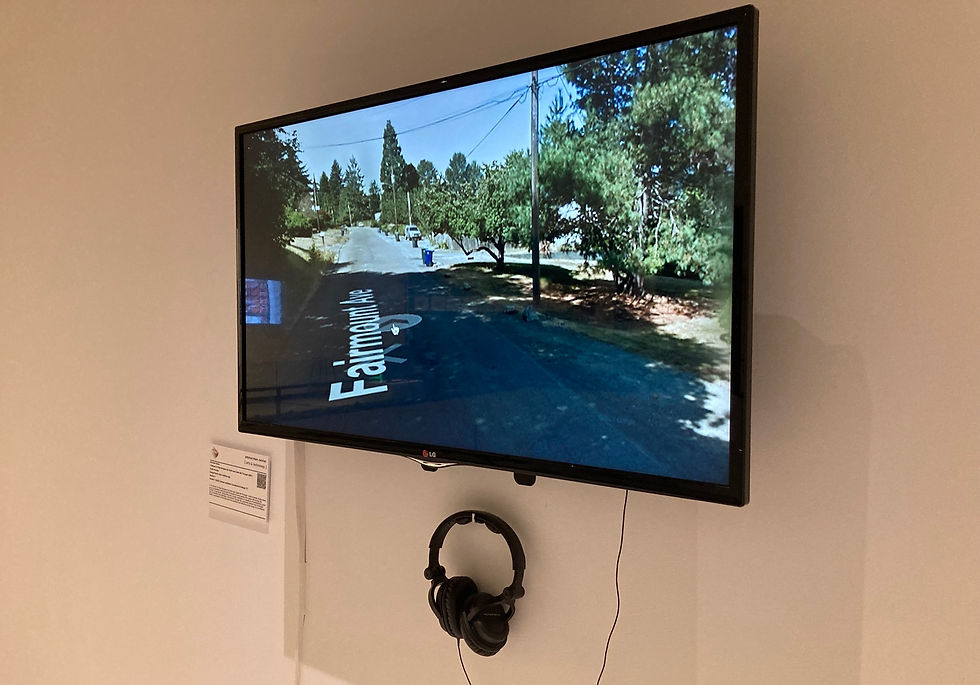
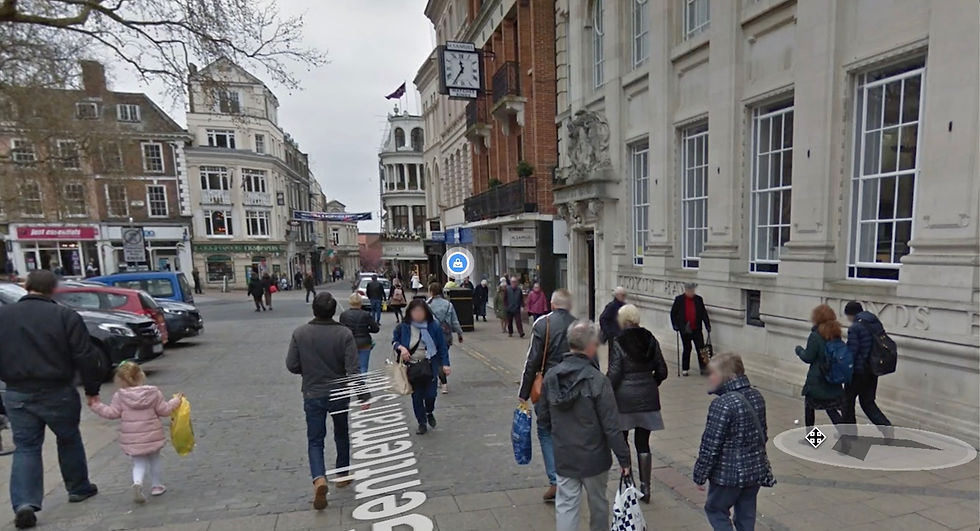
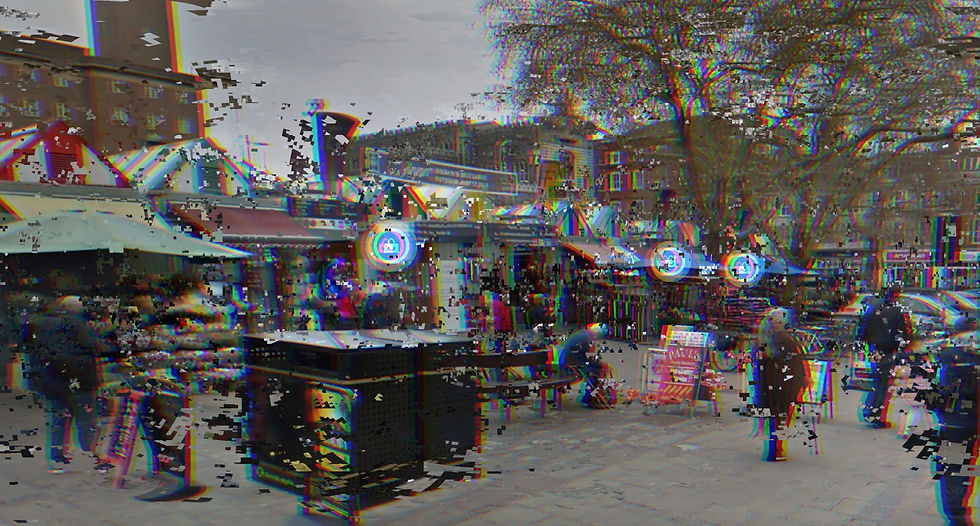

“A Stream of Data Scrapes the Earth and Casts Me Through" is a video piece composed of Google Earth walks in the locales of every person that I Zoomed with during the COVID-19 pandemic. Adopting the popular lockdown practice of walking, it meditates on the relationship between embodiment, place, and connection. Can closeness be simulated through our digital specters? What is the threshold between caretaking and surveillance? Through the sanitized, capitalistic medium of Google Earth, the piece searches for fraught connection—emotionally, physically, and digitally.
Online exhibition and video available here through Target Gallery in Alexandria, VA as part of their 2021 "A Year In" exhibition juried by Nancy Daly
Exhibited at the Virginia Tech Moss Arts Center in Student Arts Spotlight, December 2021
Exhibited in Ammerman Center for Arts + Technology Symposium Exhibition (New London, CT; November - December 2022)
"Our Bones Crosshatch..."

"Our bones crosshatch . . . " was a site-specific six-channel installation created for the historic Dartington Estate gardens in August 2019. I wanted to explore spatialization as a means of experiencing tonality and harmony. To do this, I had six speakers arranged semi-circularly in one of the clearings of the Dartington gardens. This piece uses what I term “tonal drift,” wherein a major modality is emphasized on the right side and a minor modality on the left. By moving through this circular array of speakers (in any manner of their choosing), the audience could experience a kind of harmonic dispersion rather than a linear harmonic progression.
It also uses recorded voices to investigate the unseen labor of the Dartington gardens. Dartington is steeped in ‘great man history,’ wherein the wealthy Leonard and Dorothy Elmhirst take center stage. Although the estate has existed since the 15th century, little is recorded and said of the laborers who made Dartington the landscape and space that it is today. By layering unheard voices like sedimentary strata, and evoking the humming atmosphere of the Dart river, this piece aims to bring attention to this buried history.
Throughout the day, audiences and visitors would wander across the installation, which allowed them to have a more private experience with the piece. There are essentially two blended primary sections, excerpted briefly in the videos provided. (B section at time marker 1:53)
Funded by the 2019 Koster Foundation Summer Study Grant
Exhibited at the 2019 Dartington International Summer Music School and Festival
"Glitching Glitch Feminism"
“Glitching Glitch Feminism” is an experimental remix-review of Legacy Russell’s manifesto “Glitch Feminism” (Verso Books, 2020). I actuate what Russell terms the “generative force” of glitch by ‘glitching’ direct quotes from her book, thereby trading the position of the critic for something more equitable, exploratory, and collaborative. By restricting
Exhibited at AUDIRE Sound Art Exhibition at: http://www.audire.pt/en/online-sound-art-exhibition/
my material to sounds originally produced via the body, I collapse the digital dualism binary; what is a so-called bodily ‘real’ and a digital ‘fake’ ultimately fuse and deceive the ear. I manipulate the voice to blend gender expectations and create multiple, contrapuntal vocal selves, as Russell advocates in her text.
"Enclosures"
Please skip around in your listening.
Enclosures was a site-specific installation originally created for the elevator at the Hirshhorn Museum in June, 2019. Interested in the fractured narratives that we walk into and out of, this piece adopts the elevator as its central form and stitching point. It uses space as container rather than a form on the page. It is interested in "stories"--as narrative and literal levels of a building.
Each poetic vignette lasts 30-40 seconds, the time it takes to get from the ground to the top floor of the Hirshhorn. In other words, each story
lasts one vertical story of the building, then moves with the elevator box out of sight and site. With each return of a perspective, new sonic environments and narratives emerge, but only for a glimmer. These threads amplify the liminal space of the elevator and bring these forgotten observations to the forefront of our attention. Audiences were invited to enter and exit the piece at their own will but are encouraged to return throughout the day. Certain narrative slivers return and overlap to coalesce a collective arc.
In thematic content, "Enclosures" is concerned with liminality, public-private intimacy, enclosure, narrative closure, observation, and the audioscape as temporal palimpsest.
Funded by the DC Listening Lounge/Hirshhorn Sound Scene Festival 2019
"Dart Installation"

This is the installation set-up during the night exhibit.

This is what the space looked like during the day, before installation.

This is the installation set-up during the night exhibit.
"Dart" was a site-specific, multichannel installation at the Dartington Estate Gardens in Devon, England. I was inspired by Alice Oswald's book-length poem Dart, which details the folklore and stories surrounding the river Dart. Oswald uses collage techniques to evoke what she terms "the river's mutterings" to create "a song-map of the river." The voices in her poem coagulate and move contrapuntally in a manner that I wanted to evoke through this audio installation. Short ostinatos repeat, layer, and become a menacing "muttering," until a hocket-like round emerges. In my installation, I return the poem to the site that inspired it, nestled directly next to a brook connected to the river Dart. This audio was interspersed with the sounds of the brook and the audience's footsteps. This multichannel installation used six speakers circularly arranged surrounding the garden pathway so that the listener could "mix" their own experience of the poem. The first photo above is during installation (at night with lights). Since the photo is difficult to see, the second photo shows the space in daylight prior to installation.
Funded by the 2018 Koster Foundation Summer Study Grant
Exhibited at the 2018 Dartington International Summer Music School and Festival
"In(ter)jections"

“In(ter)jections” is a sound-poetry piece designed specifically for live performance over Zoom. The piece explores how my chronically ill body forces me to accept technical difficulty as a mode of existence and performance. Using 12 sampler-loopers coded in Pure Data, I record, glitch, and layer pieces of my voice in real time.
Although some parts of the poetic text are pre-prepared in a score, the sonic glitches and recordings are always variable with each performance, opening up unexpected routes and syntactic fissures. I view the piece as collaborating with the improvisatory sonic glitches, just as I have learned to collaborate and improvise with my body’s many interruptions and interjections. The sounded text focuses on questions of productivity under capitalistic ableism, failure/shame, gendered emotions, and alternate experiences of temporality.
"Fracking the Marcellus"
"Fracking the Marcellus" is an audio poem with documentary leanings. It moves between found audio from news casts, free use field recordings from the Library of Congress, and, notably, the Gaslands documentary. The final song is Bessie Jones's "If You Meet King Jesus at the River" from the Cultural Equity Alan Lomax archives
The work focuses on widespread and largely unregulated hydraulic fracturing in my home state of Pennsylvania. It asks the questions:
-
Can land ever be "private property"? Much like sound itself, pollution overflows boundaries, especially our artificial demarcations of property.
-
How do we quantify the invisible health impacts and trace them back to the capitalist corporations, which refute accountability? Just as sound is invisible yet material in the way it acts upon and inside the body of the listener, fracking pollution imperceptibly blends into water sources and soil, infiltrating vulnerable bodies within the ecosystem--including our own.
"Fingerprint Music"

"Musical Fingerprints" was a performance/installation piece created in 2017.
Interested individuals could stop by the table and use the inking pad to create their own fingerprints, which I would scan into this program on-site with my laptop. In about 1 minute, the visitor could then "play" their fingerprint with the cursor like an instrument (as the video demonstrates) or listen to the planing harmony produced. The artwork explores the relationship between irreducible biological markers and the performativity of identity. Just as our identities and traits are expressed selectively, the individual can perform their fingerprints in the manner of their choosing. The layers of translation (from flesh to paper to code to sound) mirror the everyday ways in which we morph and translate ourselves to new environments.
Exhibited at the DC Listening Lounge/Hirshhorn Sound Scene Festival 2019





